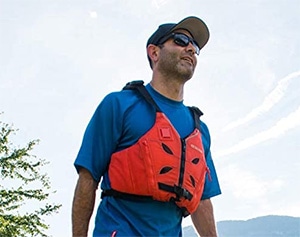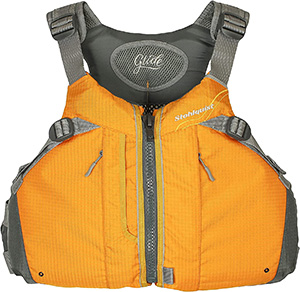If you’ve wondered how often should the inflator on a type V life jacket be checked, you’re not alone. While Type V life jackets are a popular life vest option for water enthusiasts, knowing how to properly care for one is not always common knowledge.
You should check the inflator on your type V life jacket every time you use it. You should also do a more detailed inspection every two or three months.
Today, I’ll share with you everything you need to know about keeping your life jacket well maintained. Doing so will help you elongate the life of your inflatable PFD and solidify your safety on the water.
RELATED: What are the 9 Best Paddle Board PFDs in 2024?
You Should Inspect The Inflator on Your Type V Life Jacket Every Time You Wear It

The best way to ensure that your type V inflatable life jacket is working properly is through frequent maintenance.
Unlike other types, type V life jackets have unique components that need regular care and attention. Every time you plan on using your type V life jacket, check the inflation mechanism and ensure the inflation indicator is green.
Along with checking the inflation mechanism, you always want to do a quick visual inspection every time you put on your inflatable PFD. Look for any abnormalities, tears, or other signs of damage on the fabric and inside your PFD.
Every two or three months, depending on how often you use your life jacket, you’ll want to do a more thorough inspection. This detailed inspection looks at the manual and automatic inflation mechanism, straps, buckles, and the overall construction of your life vest.
How to Inspect the Inflator on a Type V Life Jacket
There are several components you’ll need to understand when conducting a thorough inspection for your type V life jacket. These components are unique to inflatable PDFs that use CO2 cartridges to inflate on impact.
Let’s go over the process.
Inspecting the Exterior
Always start by inspecting the exterior, and make it a habit to inspect the exterior of all other life vests you have as well.
When you’re inspecting the exterior, look for any signs of damage, tears, or even mildew. Any of these issues can compromise the safety of your life jacket, even if the CO2 canister is in good working order.
Inspect Safety Harness, Straps, and Buckles
As you inspect the exterior, give your buckles, straps, and safety harness a once-over too. Look for tears, rips, or clasping issues. These harnesses and straps are important because they’re what keep inflatable life vests secured to your body when you hit the water.
Inspect Bobin Activation System
The bobbin activation system is the heart of a type V life jacket. If it’s not in good working order, or if it’s sustained any damage or deterioration, then it may not work as it should.
Your inflatable PFD should have two tube-like attachments. One is the CO2 canister, and the other is the cover that houses your bobbin. Different models will have a CO2 canister that screws directly into the bobbin. Either way, the inspection process is the same.
Start by unscrewing the CO2 canister to prevent any accidental inflation. Next, unscrew the bobbin cover and inspect it. Your bobbin will typically be yellow, with white ribbing that goes around the inside it.
Make sure that this white ribbing is intact. If it’s deteriorating or has bits that have come off, you need to replace it. Typically, when you replace a bobbin, you should also replace its CO2 canister. To re-arm your inflation mechanism, you’ll need a re-arming kit that will replace both components at the same time.
Inspect the CO2 Cylinder

Next, you should inspect your CO2 cylinder. This cylinder holds the gas that allows your life vest to inflate on impact. As you inspect it, look for any signs of rust, corrosion, dust, or any dents.
After inspecting your cylinder and your bobbin, take a look at your automatic service indicator. The indicator will be either green or red, letting you know whether or not your activation system is ready. You want it to be green – if it turns red, you’ll need to use a re-arming kit to get the status back to green.
All type V life jackets come with two inflation mechanisms, an automatic and manually inflated system.
Manual inflation is achieved through either a manual pull tab or an oral inflation tube. The manual system is typically found on the opposite side of where the CO2 inflation system is. The manual pull tab allows you to inflate the PFD in the event the bobbin system doesn’t kick in.
The oral tube allows you to inflate your life vest by popping off the cover and blowing air inside. Although you have a manual system, you should never go out into the water if your automatic service indicator is not re-armed and showing green.
Do an Overnight Inflation Test
Doing an overnight test is the easiest way to check and see if your life jacket is holding air properly.
Simply inflate your life jacket and leave it inflated for at least two hours or overnight. The next morning, check to see if your inflatable has lost any air. If it’s passed the leak test, this means that your PFD is ready to go. Deflate it, roll it back up, and prepare for use the next time you go out.
Check The Expiration Date
Type V life jackets have expiration dates because of their CO2 canisters. While the canisters do have expiration dates (which you should take note of) they can last anywhere from 2 to 4 years if properly maintained. Just be sure to never use one that has expired when re-arming your inflatable PFD.
While life vests themselves do not have expiration dates, they can become void if they are defective. If there are visible signs of wear and tear, you’ll need to replace your PFD, regardless of whether or not the Inflation system is intact.
Read The Manufacturer’s Instructions
While most inflatable life jackets operate the same way, you’ll still need to read and understand your manufacturer’s instructions. Different brands design their inflatable PFDs differently. This can change the way you maintain the integrity of your life jacket.
Store Your Life Jacket Properly
Finally, it’s important to store your life jacket properly so that it lasts as long as it should.
Don’t store your inflatable PFDs in direct sunlight or direct heat. Keep them inside in a cool place instead. Read the care and storage label for any additional instructions.
Simplify Maintenance: Consider Inherently Buoyant Life Jackets Instead
Type V life vests are one of the most popular types of personal flotation devices on the market. They’re not as bulky as other life vests, and they offer you the versatility and freedom to move as you like.
Plus, they do a better job of not retaining body heat, and keeping you cool during the warmer months.
With this freedom comes the cost of more frequent maintenance. Type V PFDs require you to be extra careful with your care and maintenance.
One of the best ways you can alleviate this stress of regular maintenance is by opting for an inherently buoyant life jacket instead. Inherently buoyant life jackets don’t require as intensive maintenance because they don’t use a CO2 activation system for inflation. Instead, these models feature a foam interior that keeps you afloat the moment you hit the water.
Final Thoughts
Despite requiring a fair deal of care and maintenance, using inflatable PFDs is one of the best ways to enjoy yourself and stay safe while on the water.
It’s important that if you are going to use type V PFDs, you understand how to properly care for the inflator so that your PFD works as it should. Read your instructional manual and test your inflator out before hitting the water.

